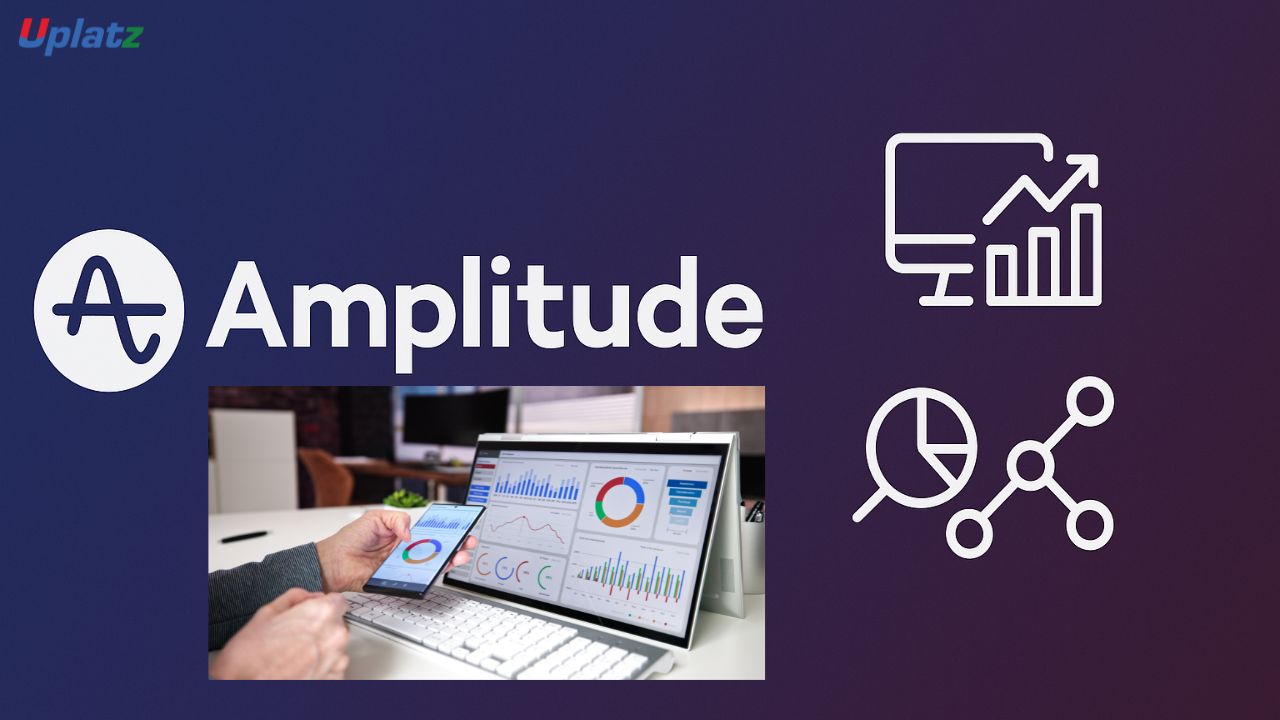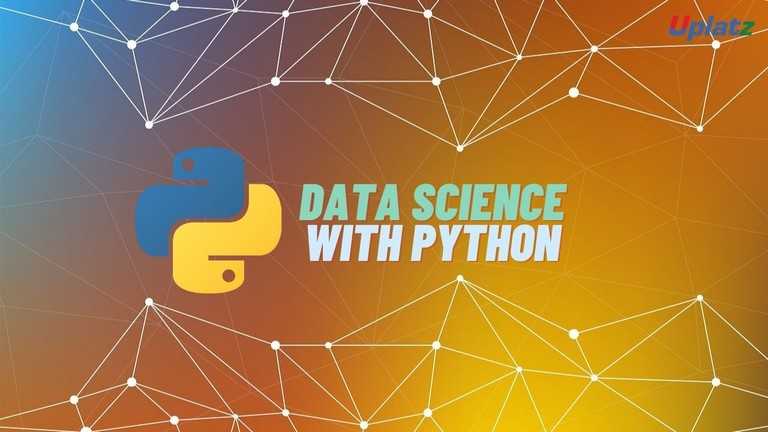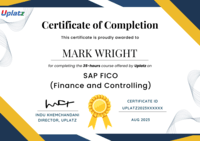Amplitude
Learn advanced product analytics with Amplitude to understand user journeys, boost engagement, and drive product-led growth. Price Match Guarantee
Full Lifetime Access
Access on any Device
Technical Support
Secure Checkout
Course Completion Certificate
Price Match Guarantee
Full Lifetime Access
Access on any Device
Technical Support
Secure Checkout
Course Completion Certificate
 96% Started a new career
BUY THIS COURSE (
96% Started a new career
BUY THIS COURSE (GBP 12 GBP 29 )-
 86% Got a pay increase and promotion
86% Got a pay increase and promotion
Students also bought -
-

- Data Science with Python
- 45 Hours
- GBP 12
- 2931 Learners
-

- Google Analytics
- 20 Hours
- GBP 12
- 372 Learners
-

- Web Analytics
- 3 Hours
- GBP 12
- 86 Learners

Amplitude: Product Analytics & User Insights is a comprehensive, self-paced online course designed for product managers, data analysts, marketers, UX designers, and growth professionals who want to make smarter, data-driven product decisions. This course teaches how to use Amplitude’s powerful product analytics features to track user journeys, uncover behavioral insights, analyze engagement, and measure retention—helping teams build products that users love and keep coming back to.
At its foundation, Amplitude is a world-leading product intelligence and digital analytics platform that empowers organizations to understand how users interact with their products. Unlike traditional web analytics tools that focus on clicks and page views, Amplitude takes a behavioral and event-based approach, allowing teams to analyze specific user actions—such as sign-ups, purchases, feature usage, and in-app engagement—and connect them to key business outcomes like retention, conversion, and revenue growth.
In this course, learners start with the fundamentals of Amplitude—from setting up tracking plans and creating event taxonomies to implementing analytics dashboards. You’ll learn how to capture high-quality user data that reflects real interactions, then explore how to structure and interpret this data to answer critical product questions such as:
-
Which features drive engagement and long-term retention?
-
Where are users dropping off in the journey, and why?
-
How do different user cohorts behave over time?
-
What product improvements can lead to higher conversions or fewer churns?
As you move forward, the course delves into advanced Amplitude features, teaching you how to design meaningful analyses using funnels, cohorts, segments, and retention models. You’ll learn how to visualize the complete user journey—from first interaction to conversion—allowing you to identify bottlenecks and opportunities for growth. You’ll also explore how to use Amplitude’s segmentation tools to analyze user behavior by device, region, acquisition channel, or demographic, helping you tailor strategies for different audiences.
One of the most powerful aspects of Amplitude is its cohort analysis capability, which enables you to group users by shared characteristics or behaviors and track their engagement over time. This course provides hands-on practice with building cohorts, analyzing retention curves, and understanding the lifetime value of different user segments. By mastering this, you’ll gain the ability to predict user behavior, design personalized experiences, and improve customer loyalty through data insights.
Another key component of this course is experimentation and predictive analytics. You’ll learn how to use Amplitude Experiment to design A/B tests, measure their outcomes, and make data-informed decisions about product changes. Additionally, you’ll explore Amplitude’s predictive tools that use machine learning models to forecast future user actions—such as churn probability or likelihood to convert—enabling proactive growth strategies instead of reactive fixes.
Through real-world projects, you’ll apply Amplitude to practical product scenarios. You’ll track events, build dashboards, analyze funnels, and interpret data to uncover trends and inform business strategies. These projects mirror the tasks faced by professionals in SaaS companies, e-commerce, and digital startups, helping you build analytical confidence and a strong professional portfolio.
This course goes beyond tool usage—it helps you develop an analytical mindset. You’ll learn how to ask the right questions, structure data for decision-making, and communicate insights effectively across teams. By the end, you’ll be equipped not only to use Amplitude but also to drive measurable business impact using data-driven insights.
Why Learn Amplitude?
In today’s data-driven world, digital products succeed or fail based on how well teams understand their users. Amplitude bridges the gap between product design and business performance by turning raw behavioral data into actionable insights.
Learning Amplitude allows professionals to:
-
Understand why users behave the way they do – go beyond vanity metrics and focus on real behavioral drivers.
-
Make informed decisions using event-based data rather than assumptions.
-
Improve product engagement and retention through continuous experimentation and optimization.
-
Collaborate effectively across product, marketing, and data teams using shared dashboards and reports.
-
Drive sustainable growth by measuring the true impact of every feature or campaign.
Global organizations like Atlassian, PayPal, Shopify, and HubSpot rely on Amplitude to power their growth and product intelligence. As businesses increasingly adopt product analytics platforms, professionals skilled in Amplitude are in high demand across industries.
What You Will Gain
By completing this course, you will be able to:
-
Track and analyze user behavior with event-based analytics: Learn how to plan event structures, implement tracking, and collect accurate behavioral data to understand user journeys.
-
Build funnels to understand conversions and drop-offs: Visualize step-by-step user flows to identify friction points and optimize conversions.
-
Run retention and cohort analyses for product growth: Learn to evaluate long-term engagement and identify factors driving repeat usage.
-
Use Amplitude dashboards and reporting tools: Create clear, visually engaging dashboards to communicate insights across teams.
-
Apply predictive analytics and experimentation for decision-making: Use machine learning insights and A/B testing to make informed, data-backed improvements.
-
Segment users based on behavior: Discover how to group users into cohorts to tailor engagement and retention strategies.
-
Integrate Amplitude with your tech stack: Connect Amplitude to CRMs, marketing automation tools, and data warehouses for a complete analytics ecosystem.
-
Translate data into business outcomes: Learn to interpret findings, tell compelling data stories, and present results that drive executive decisions.
Who This Course Is For
This course is ideal for professionals across disciplines who want to make sense of user data and drive growth through analytics:
-
Product Managers who want to identify which features matter most and prioritize product improvements.
-
Data Analysts who need to interpret behavioral data and generate actionable insights for product teams.
-
Marketers looking to measure campaign effectiveness and understand customer journeys.
-
UX Researchers & Designers validating how design changes impact user engagement and retention.
-
Startups & Entrepreneurs using analytics to test ideas, validate product-market fit, and improve customer experiences.
-
Students & Professionals seeking to strengthen their understanding of analytics tools and product data interpretation.
Course Highlights
-
Comprehensive learning journey: From foundational setup to advanced analytics, the course covers every stage of Amplitude usage.
-
Real-world applications: Learn by analyzing real datasets and working on projects inspired by real business problems.
-
Hands-on practice: Apply every concept through guided exercises and live data simulations.
-
Data storytelling focus: Develop the ability to turn data into clear insights and actionable narratives.
-
Cross-functional perspective: Understand how product, marketing, and data teams can work together through Amplitude.
Hands-On Projects
Throughout the course, you’ll complete practical exercises designed to reinforce learning:
-
Event Tracking Setup: Create an event taxonomy and implement tracking for a web or app environment.
-
Funnel Analysis Project: Build and analyze funnels to identify drop-off points and optimize conversions.
-
Cohort Retention Study: Perform cohort analysis to study user engagement patterns over time.
-
Experiment Design: Conduct A/B testing to measure the effect of new product features or marketing campaigns.
-
Dashboard Reporting: Build dashboards summarizing user metrics and key product KPIs for executive review.
These projects simulate real industry workflows and give you tangible examples to include in your professional portfolio.
Learning Outcomes
By the end of this course, you will have mastered the skills to use Amplitude for end-to-end product analytics and user insights. You’ll understand how to plan tracking, analyze behavioral data, segment audiences, and derive insights that fuel business growth.
You’ll be able to move beyond surface-level metrics and focus on what truly matters—how users engage, what drives retention, and how to build better products through continuous learning and iteration.
Whether you are enhancing an existing product or building a new one, this course gives you the analytical tools and strategic mindset to make confident, data-driven decisions using Amplitude.
By the end of this course, you will be able to:
-
Set up event tracking and user properties in Amplitude
-
Build and analyze funnels for product workflows
-
Perform cohort and retention analysis
-
Create interactive dashboards for product teams
-
Run A/B tests and use predictive features to forecast user actions
Course Syllabus
Module 1: Introduction to Amplitude
Module 2: Event Tracking & User Properties
Module 3: Funnels & Conversion Analysis
Module 4: Retention & Cohort Studies
Module 5: Segmentation & User Journeys
Module 6: Dashboards & Reporting
Module 7: Predictive Analytics & Experimentation
Module 8: Real-World Projects (Mobile App Analytics, E-commerce Funnel)
Module 9: Interview Questions & Answers
Upon completion, learners will receive a Certificate of Completion from Uplatz validating their expertise in product analytics and user insights with Amplitude.
This course prepares learners for roles such as:
-
Product Analyst
-
Growth Marketer
-
Business Intelligence Specialist
-
Product Manager
-
Data Analyst (Digital Products)
-
What is Amplitude and how does it differ from Mixpanel?
Answer: Both are event-based analytics platforms, but Amplitude is known for its advanced retention, cohort, and predictive analytics, while Mixpanel is often praised for funnel analysis and experimentation. -
What is event-based analytics in Amplitude?
Answer: It tracks user actions (events) like signups, purchases, or clicks, enabling deeper insights into user behavior compared to pageview-based tools. -
What is a cohort in Amplitude?
Answer: A cohort is a group of users who share common traits or behaviors (e.g., users who signed up in January) used for analyzing retention or engagement. -
How do funnels work in Amplitude?
Answer: Funnels track a sequence of steps users take toward a goal, highlighting where users drop off or convert. -
Can Amplitude be integrated with other platforms?
Answer: Yes, Amplitude integrates with tools like Segment, Google BigQuery, Snowflake, Slack, and marketing automation platforms. -
What is the purpose of predictive analytics in Amplitude?
Answer: It forecasts user behavior, such as likelihood of churn or purchase, helping teams take proactive actions. -
How can Amplitude help in product-led growth?
Answer: By providing data on which features drive engagement, teams can prioritize product decisions that directly improve user retention and growth. -
What are retention curves in Amplitude?
Answer: Retention curves show how many users return to perform a key action over time, helping identify whether a product is sticky. -
What are common challenges with Amplitude?
Answer: Ensuring proper event tracking setup, managing large datasets, and aligning analytics with business goals. -
How would you use Amplitude for a SaaS product?
Answer: Track onboarding success, measure feature adoption, analyze churn, and run A/B tests to optimize user retention.









